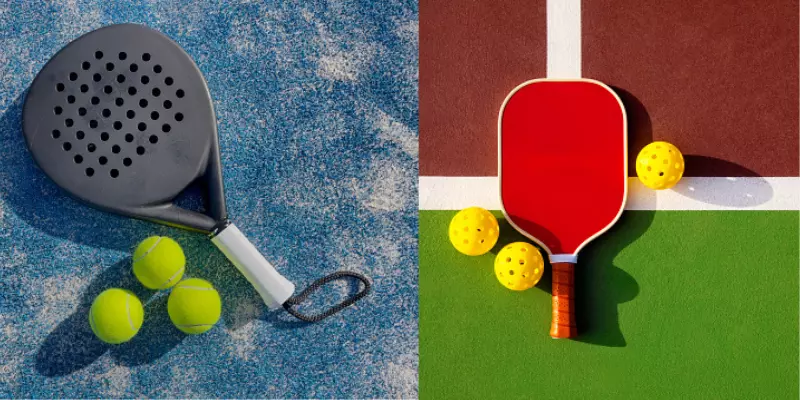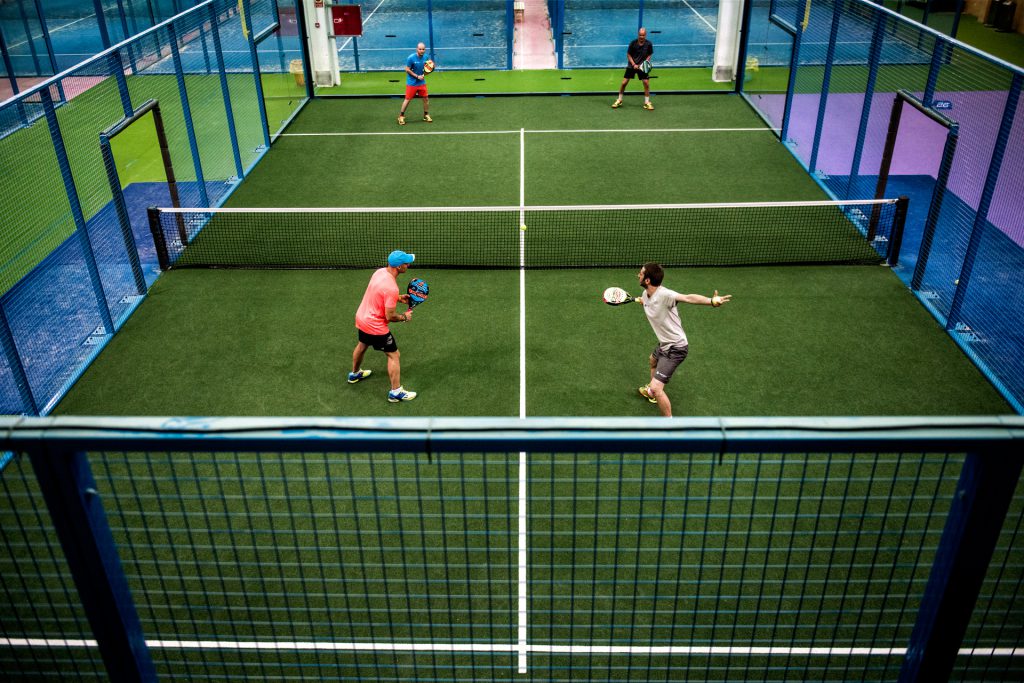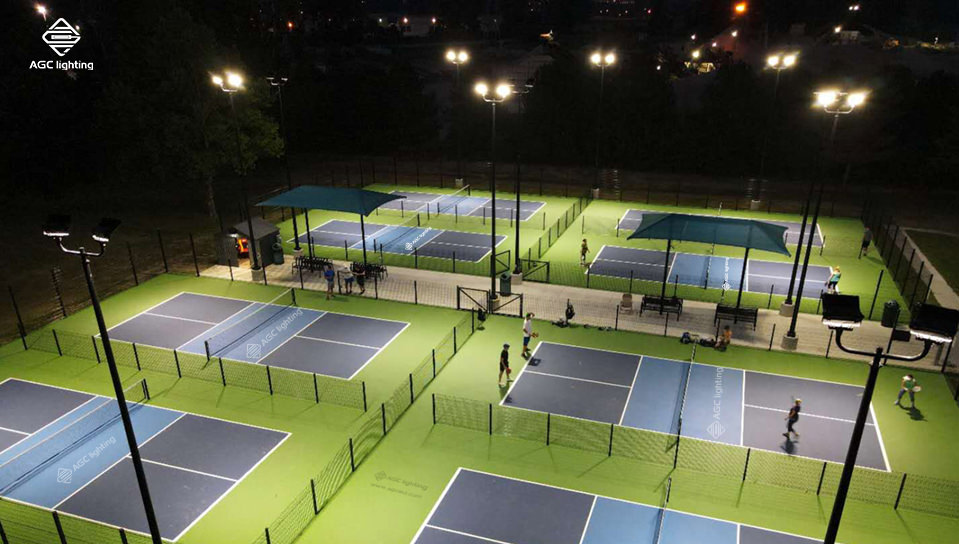Today, we delve into the nuances between two increasingly popular games: padel and pickleball.
Table of Contents
At first glance, these sports might seem quite similar, but a closer look reveals some fascinating differences that set them apart.
A bit of history
Pickleball was created in 1965 by Joel Pritchard and Bill Bell. Curiously, both were born one day and later on became business partners and friends.
It all began when they decided that they wanted to play badminton, however, they did not have any of the proper equipment. So they chose to use ping pong paddles and a perforated plastic ball. In the beginning, they would just volley back and forth.
But soon enough they evolved the game and by 1967 the first court was created in Joel’s backyard and in 1972 a corporation was formed to protect the sport. Finally, in 1976 the sport was nationally recognized in the United States.

Padel has a much different story. Padel was invented in 1969 by Enrique Corcuera en Puerto de Acapulco, México.
Enrique decided to adapt his squash court with elements of platform tennis. He introduced his new sport to his friend Alfonso of Hohenlohe-Langenburg who fell in love with the sport. Eventually, the two made the first official courts in 1974.
Over time the sport evolved through the addition of modifications and by 1975 it was well renowned in all of Latin America. In the early 2000s, there were over 1500 padel clubs established worldwide with many international tournaments being played year-round.
The comparison between these two sports was bound to happen and while Padel is one of the most popular racquet sports in the world, Pickleball is extremely popular in the USA.
The question though, is how much overlap there is between the two. For starters, it is the court size.
Court difference

The Padel Court has different dimensions than Pickleball. The Court is 10 meters wide and 20 meters long. Similar to Pickleball, the court is divided in half by the net and also has service lines on each side.
The net and service area are then divided by a line down the middle, creating two equal blocks. The biggest difference between the two besides the dimensions is that the Padel court is enclosed by a combination of glass/cement wall and wire mesh fence. The purpose of the walls is to give the ball height and distance.

The Pickleball court has the same dimensions as badminton. The court is 6.1 meters long, and 13.4 meters wide. The court is divided in half by the net and has service lines on each side. The net and service area are then divided by a line down the middle creating two equal blocks. The Pickleball court also has a zone close to the net called the no volley zone.
Equipment difference
The biggest pieces of equipment needed for both games are a paddle and a ball. In Pickleball the type of paddle you will use depends.
There are three different types of pickleball and those are wood, composite, and graphite.
- Wood is the least expensive of them all however, it is the heaviest as well.
- Composite paddles are a happy medium. They are mid-price and come in a variety of weights and sizes.
- Graphite is the most expensive but can be very light and powerful.
Here’s a useful source on best pickleball paddles
In Padel, there are also three types of rackets used; power, control, and multipurpose. Power rackets were made for players that want to be more offensive than defensive. They provide the extra edge you need to be an aggressive player. Control rackets give the player more control over the ball rather than power.
These rackets are meant for players that do not need as much power and prefer to play a defensive/ strategic type of game. The last of the racket is multipurpose. This type of racket is the best of both worlds, as it seeks to give the player both control and power over the ball.
Here you can find a wide offer of padel rackets
Rules difference
Similar to Tennis, pickleball is played in singles or doubles. You serve below the waist and serve off a bounce. Additionally, you are only allowed one attempt at serving. A fault is committed when one of the following happens.
- The ball touches any part of the no volley zone on the serve
- The ball goes out of bounds
- The ball does not clear the net
- The ball is volleyed from the no-volley zone
- The ball strikes you or your teammate
The serve must go diagonally and clear the no volley zone. Pickleball has a two-bounce rule. The two-bounce rule means that if the ball bounces twice, then it is deemed unplayable and a point will be awarded to the other players. The traditional pickleball game is played to 11 points, and you must win by 2. There are no sets, it’s just a singular game.
Padel traditionally is played in doubles due to the fast-paced environment, but you can play singles as well. You also serve below the waist and serve off of one bounce. The ball must go diagonally onto the other side of the court. To win a point, one of four things must happen.
- The ball bounces twice.
- The ball does not clear the net.
- The ball strikes you or your teammate.
- The ball hits the wire fencing or another fixture before going over the net or bouncing on the opponent’s court (classed as out of bounds).
The point system is very similar to that of Tennis. A traditional game is made up of three sets, and each set consists of six games. Each game is played to four points (love, 15, 30, 40) and you must win by two. The winner is declared when one team wins two out of three sets.
Tips and Strategies for playing Pickleball
Pickleball is slower-paced compared to padel, but there still is a technique that needs to be learned to succeed at this game. The following are a couple of techniques and strategies you can use to better your playing style.
1. Consistently serve deep to the backhand side
Serving deep will push your opponent back past the baseline and make it harder to return due to the length of the shot. The backhand is also traditionally an opponent’s weaker side so targeting that will make their ability to return much more difficult.
2. Always be moving your feet and bend your knees
Moving your feet and bending your knees sounds simple, but it is easy to forget. When it comes to hitting shots, foot placement is vital. Constantly moving will keep you prepared to make any shot with accuracy and power. Bending of the knees will additionally help you in getting those lowball shots more easily.
3. Always watch the ball hit the paddle
There are many distractions on the court and watching the ball hit your paddle will allow you to be more consistent with your shots and commit fewer errors.
4. Stay patient
Usually, the opponent that starts to speed the ball up will lose the point. Let the speed build gradually throughout the point, and only attack attackable balls. Don’t try to force anything.
Tips and Strategies for playing Padel
Padel is faster-paced when compared to Pickleball. As stated above, it is traditionally played in doubles, so below are our tips and tricks for this playing style.
1. Play on the opponent’s weakness
Playing on your opponent’s weakness is one of the oldest strategies for any sport in the world. Every player has a weakness, so be attentive to the way your opponent plays and if you notice something they do wrong, then expose them for it.
2. Target one player
Targeting one player will do one of two things. 1. The targeted player will become more pressured and will most likely mess up. 2. The player that is not pressured will become frustrated and won’t be warm, so if the ball comes to them, they will not be prepared.
3. Make your opponent’s move
Making your opponents move not only tires them out, but they are also more likely to make a mistake if they’re constantly moving.
4. Communicate with your partner
Communication with your partner is one of the most important things in padel. Whether it comes to claiming a ball, discussing an opponent’s weakness, or trying to slow down or speed up the game. Communicating also helps build chemistry between you and your partner.
Final Thoughts
In conclusion, Padel and Pickleball may seem similar but are vastly different.
For starters, the court differences. The pickleball court is smaller and requires less movement, unlike the padel court. The padel court also has walls to take into account.
Each sport requires different types of paddles, and each paddle has different purposes. The rules are similar, however. Most of them coincide with each other, except for serving requirements and the walls in padel.
Lastly, each sport has different tips and strategies because of all the differences stated above. I hope you find this helpful when figuring out the differences between the two sports.